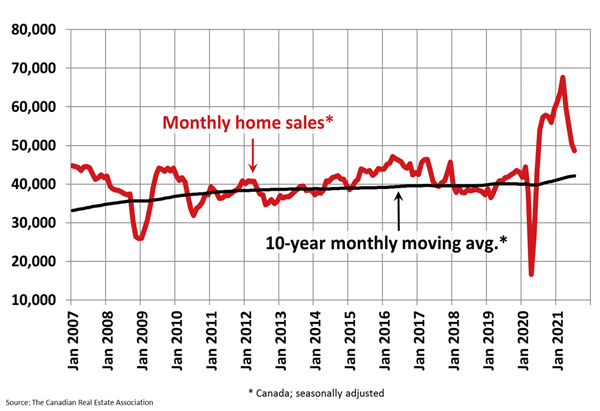OTTAWA, Ontario (Wednesday, August 18, 2021) – National home sales declined a further 3.5 percent, on a month-over-month basis, in July, marking the smallest of four consecutive declines since March, according to statistics, released on Monday, by the Canadian Real Estate Association (CREA).
While sales are now down a cumulative 28 percent from that March peak, Canadian housing markets are still historically quite active.
Month-over-month declines in sales activity were less broad-based than seen in the past few months, although sales were still down in about two-thirds of all local markets (See Chart A below).
Declines were led by Edmonton and Calgary, although that may be because the current trend of softening sales is a little more recent in these markets. In a market like Montreal, where sales began to moderate way back at the start of the year, activity edged up, month-over-month, in July.
The actual (not seasonally adjusted) number of transactions in July 2021, was down 15.2 percent, on a year-over-year basis, from the record for that month, set last July. July 2021 sales, nonetheless, still marked the second-best month of July on record.
“The slowdown we’ve seen in home sales over the last few months has not been surprising, given that the level of activity we were seeing, back in March, was unsustainable,” said Shaun Cathcart, CREA’s Senior Economist.
“But we are not returning to normal, we are only returning to where we were, before COVID-19, which was a far cry from normal. The problem of high housing demand, amid low supply, has not gone anywhere – it’s arguably worse. And after years of everyone agreeing that medium-density housing was the future, we are still referring to it as the ‘missing’ middle.”
The number of newly-listed homes dropped by 8.8 percent in July, compared to June, with declines led by a who’s who of big Canadian markets – the Greater Toronto Area (GTA), Montreal, Vancouver and Calgary. Across the country, new supply was down in about three-quarters of all markets in July.
This was enough to noticeably tighten the sales-to-new listings ratio, despite sales activity also slowing on the month. The national sales-to-new listings ratio was 74 percent in July 2021, up from 69.9 percent in June, and the long-term average, for the national sales-to-new listings ratio, is 54.7percent.
Based on a comparison of sales-to-new listings ratio with long-term averages, the tightening of market conditions in July tipped a small majority of local markets back into seller’s market territory, reversing the trend of more balanced markets seen in June.
Another piece of evidence that conditions may be starting to stabilize was the number of months of inventory. There were 2.3 months of inventory on a national basis at the end of July 2021, unchanged from June. This is extremely low – still indicative of a strong seller’s market at the national level and in most local markets. The long-term average for this measure is twice where it stands today.
“While the moderation of sales activity continues to capture most of the headlines these days, it’s record-low inventories that should be our focus,” argued Cliff Stevenson, Chair of CREA.
“We still have extremely unbalanced housing markets, all over the country, so your best bet is to consult with your local real estate agent for information and guidance, about buying or selling a home in these still unprecedented and challenging times.”
CREA’s Aggregate Composite MLS® Home Price Index (MLS® HPI) rose 0.6 percent, month-over-month, last month, continuing the trend of decelerating month-over-month growth that began in March (See Chart B). That deceleration has yet to show up in any noticeable way on the East Coast, where property is relatively more affordable.
Additionally, a more recent point worth noting (and watching) just in the last month or so, has seen prices for certain property types in certain Ontario markets look like they might be re-accelerating. This could be in line with a re-tightening of market conditions in some areas.
Additionally, CREA’s non-seasonally adjusted Aggregate Composite MLS® HPI was up 22.2 percent, on a year-over-year basis, in July; and, while still a very large gain, it was, as expected, down from the record 24.4 percent year-over-year increase in June.
“The reason the year-over-year comparison has started to fall is that we are now more than a year removed, from when prices really took off last year, so last year’s price levels are now catching up with this year’s, even though prices are currently still rising from month to month,” explained the national real estate association in its monthly statistics report.
The actual (not seasonally adjusted) national average home price — heavily influenced by sales in Greater Vancouver and the GTA, two of Canada’s most active and expensive housing markets — was a little over $679,000 in June 2021, up 25.9 percent from the same month last year. Excluding these two markets from calculations cuts more than $135,000 from the national average price.
 Pride News Canada's Leader In African Canadian & Caribbean News, Views & Lifestyle
Pride News Canada's Leader In African Canadian & Caribbean News, Views & Lifestyle







